Jaowyn Country
The Jatbula Trail and the Larapinta Trail are the Northern Territory’s most famous walks but are altogether different beasts. The highlights of the Larapinta are the views and vistas, whilst the Jatbula excels in splendid and superb campsites.
Continued from Northern Australia Part 1 – Wildlife Around Darwin
Trail Logistics
A great benefit to walking the Jatbula Trail is the permit system restricting the number of hikers on the trail to fifteen per day. The downside of which, is that this sought after hike often sells out within hours of the permit system coming online each November, when a certain degree of determination and luck is needed to secure a spot. It is a one-directional trail with walkers allocated set campsites each night, the only variation being a completion time of five or six days.
Trail Marker.

A useful guidebook to complement walking is titled “The Jatbula Trail” written by Peter Eve/Monsoon Studio. I purchased the guidebook from the NT Museum Bookshop in Darwin but it is available online at http://jatbulatrail.com.au/ Not the most detailed walking guide but useful maps and basic info on flora and fauna.
Gecko Tours provide a daily transfer to/from the Jatbula Trailheads. The daily bus picks up hikers at the trail terminus at Edith/Falls (Leilyn) at 1.30pm returning to Katherine Visitor Centre 2.15pm and onwards to Nitmiluk Gorge at 2.45pm. The daily Greyhound Bus from Darwin to Katherine arrives in time for walkers to connect to this transfer service from the Katherine Visitor Centre out to Nitmiluk Gorge.
The last Greyhound Bus from Katherine to Darwin is late morning and so it is not possible to finish the walk and return to Darwin the same day, an overnight in Katherine is necessary.
Walkers on the transfer service that have just completed the trail are an excellent source of up to date information when transferring between Edith Falls (Leilyn) and Nitmiluk Gorge via Katherine Visitor Centre. Advice on campsites proved especially invaluable for my time at Seventeen Mile Falls.
Attendance at one of the two daily ranger talks is mandatory to obtain the boat pass necessary to cross the Katherine River and start the walk. Ideally the Gecko Transfer connects in time for the 3pm ranger talk at Nitmiluk Visitor Centre for a 7am start the following morning. A delay involving my Greyhound Bus Service from Darwin meant this connection didn’t happen for me and so I attended the 8am ranger talk the following morning (with the majority of the group) and started walking at 9am. The boat pass can be obtained here
https://www.nitmiluktours.com.au/gorge-experiences/gorge-tours/jatbula-trail-transfer
Camping at Nitmiluk Gorge prior to walking is highly advisable. The busy campsite has a nice pool, and the Visitor Centre a cafe serving coffee, snacks and meals.
https://www.nitmiluktours.com.au/accommodation/campground
Fellow hikers that were on my Greyhound Service, spent the night in Katherine. A taxi was diligently booked for the following morning prior to going to bed. The taxi was a no-show and when Katherine Taxis were contacted they advised they would be attending to regular pickups first. These hikers missed the rangers talk and wouldn’t have walked at all that day had the rangers had not kindly provided an additional talk for them. They eventually started walking at 10am on a 35C day, a dangerous situation indeed and a shit service by Katherine Taxis.
Day 1 – Nitmiluk Gorge to Biddlecombe Cascades – 8.3kms.
The trailhead for the Jatbula Trail is on the far side of the croc infested Katherine River and so hikers hitch a ride on a gorge tourboat for $15 to transfer across. When the boat nudged the opposite riverbank a tumble of walkers and backpacks spilled onto the bank and scrambled up to the orientation signage for the trail. This was it, the start of the Jatbula Trail….
Jatbula Orientation Signage.

The time was 9.30am and the sun had been slowly climbing for three hours and the temp was approaching 30C. For the first hour the trail traversed the side of the escarpment through sparse savannah woodland, before arrival at a black hill signalled approach to the first trail waterhole, Northern Rockhole.
The final approach to Northern Rockhole is along a dry creek bed and involves some rock hopping. The waterhole itself was a shady oasis after the heat of the trail, although the waterfall itself was nothing more than a small trickle this late in the dry season.
The pack was quickly ditched and in no time I was down to my shorts and enveloped in the well-shaded waters of the sublime swimming hole. The water temperature was just perfect, refreshingly cool but pleasingly not cold. Striking out with large strokes across the swimming hole, somewhere on planet earth 🌍 all the planning and effort to get to the Jatbula Trail was rewarded.
Northern Rockhole.

To have spent eternity here would have been wonderful, but the relentless climb of the mercury was incessant, so reluctantly I once again shouldered the pack, doused my shirt and hat with pool water and pressed on for the remainder of that first day.
The distance to the campsite that night was a further four kilometres and the terrain was much the same as earlier in the day with one exception. A gentle but lengthy climb up the escarpment, which would have been fine had the temperature not been approaching the high of 35C. My water soaked hat and shirt were dry within an hour.
Once the ridge of the escarpment was crested the track became sandy on the approach into Biddlecombe Falls Campsite. Despite having walked only half a day, it was clear that there was plenty flowering in the bush at this time of year. There were the radiant yellows of the Kapok and Acacias, the mellow purples of Osbeckias and Fringe-lilies and the jazzy orange of Darwin Woollybutt blooms and Fern-leaved Grevillea.
During August the Fern-leaved Grevillea is in mass flower and easily the most common flower on the trail. Globules of nectar (seen in the picture below) provided a feast for birds by day and the fruit bats by night. Numerous times when flagging on the trail I ran my finger along this nectar-laden flower for a sweet hit of sugar.
Fern-leaved Grevillea (Grevillea pteridifolia.)

The campsite set back from the waterfall in bush is spacious, although not especially shady. Although, this was by far my favourite campsite on the trail with the hypnotic sound of the waterfall nearby.
A short rocky path leads from the campsite down to a series of shallow rocky pools at the top of the falls which have an amazing aspect over Seventeen Mile Valley. The pools were employed by fellow Jatbula walkers relaxing and chatting, and a pleasant afternoon was spent getting to know one another.
Stunning Biddlecombe Falls.

The remainder of my afternoon was spent lounging lazily like a lizard on the warm rocks at the base of the picturesque falls while the crisp waters lapped my feet. When the tropical sun became too much I swam in the cool waters at the base of the falls, and for a few hours it seemed as if the entire world belonged there.
Smoky Sunset from above Biddlecombe Falls.

The group enjoyed dinner at the campsite as the day was drawing the last of her colours. Once the ground had cooled I set up the tent. I had confirmed the expected weather before walking and slept without a flysheet so I could look up at the stars and planets spinning through the night sky. After the exertions of the day and with the sound of distant water tumbling over the falls, sleep came quickly.
Day 2 – Biddlecombe Cascades to Crystal Falls – 11.5kms.
My eyes opened the following morning to a kaleidoscope of colours in the dawn sky, the morning was cool but not cold. After breakfast as the rest of the group set off on the trail I couldn’t resist a last swim at the base of the falls. An hour was spent soaking up the splendour and splashing around before setting off on the Jatbula once again.
The first part of the walk was through an impressive stand of Banksia dentata. This the only banksia found in the tropics of Australia flowers from November through June, so regrettably it is only early season walkers that are likely to see the species in bloom.
After a small creek crossing which proved no trouble, the trail wound through sandstone country. The going was easy and the terrain flat until after an hour, a large rocky outcrop broke the skyline. This impressive sandstone outcrop contained Jaowyn Rock Art, and so in the shade provided I took a coffee break to enjoy the indigenous artistry.
The Jatbula Trail is a songline for the indigenous Jaowyn people linking the wet and dry season habitation areas and so contains numerous important rock art sites. Some sites are accessible to walkers but others, especially I suspected those in parts of The Ampitheatre are sacred and understandably off-limits.
It was a tranquil spot and the sandpalms dotted throughout the outcrop rustled in the mid-morning breeze, while a backdrop of birdcall from a nearby forest of Fern-leafed Grevillea was truly stupendous.
Jaowyn Rock Art and a Sand Palm (Livistonia inermis.)
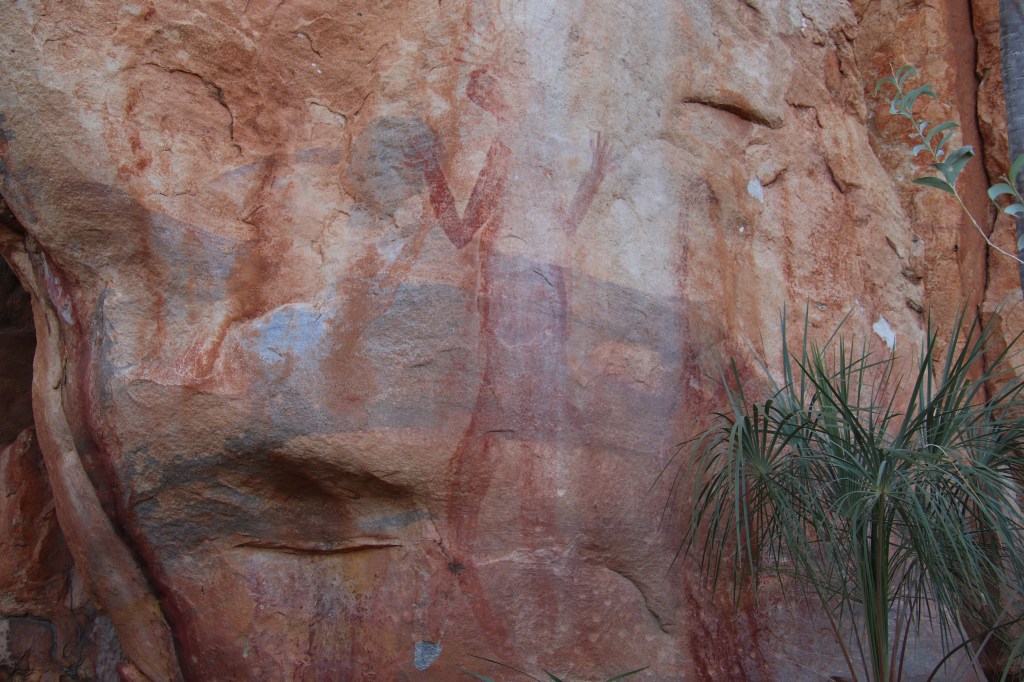
It was such a fabulous spot, I found it hard to tear myself away, but when descending the steep rocky gully away from the rock art site, it was obvious the early morning coolness had truly disappated .
A beautiful shady paperbark-lined creek provided further relief from the overhead sun, although this time I didn’t linger.
Paperbark Creek.
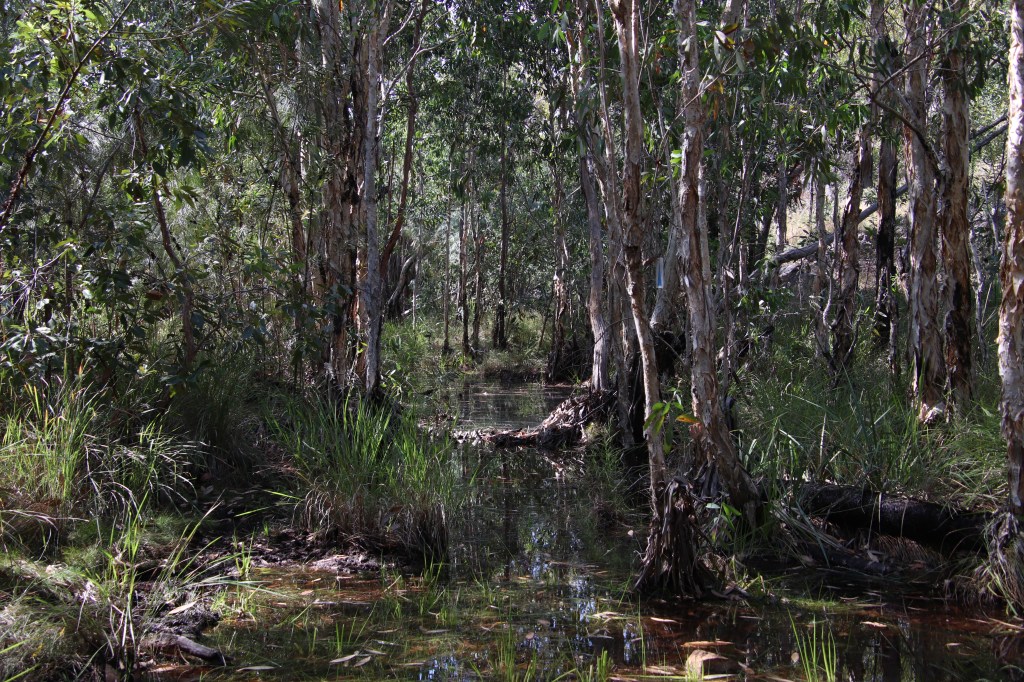
The track undulated through woodland for five kilometres and the scenery remained much the same with an occasional view from the escarpment to Seventeen Mile Valley below. The hot, sharp sun was beating down mercilessly from above and heat was radiating from the rocks underfoot. Overly confident with the short walking distances I began to understand the rangers advice to walk early.
The trail descended along a series of rocky gullies where there was a second rock art site for the day. I briefly enjoyed the shade and rock art but this time didn’t loiter. This second rock art site indicated the final approach to camp and for that I was glad. It was around 1pm when I crested the final rise and stumbled down the hill into camp. I was well and truly cooked.
The Crystal Falls Campsite consisted of a series of cleared sites in the riverine vegetation adjacent to the creek. Space was not a luxury at this campsite, and being one of the last walkers in, I had to make do with the last cleared site furthest away from the track. At least it was a shady campsite, although every branch and leaf seemed to covered with industrious green tree ants that packed a nasty sting.
Crystal Creek meandered past the campsite and in places it was still and deep, it’s beauty enhanced by numerous purple Water Lilies nudging the riverbank. I stripped down to my shorts and joined the other bathers in the creek. The cool waters felt amazing on sunburnt skin as I washed off the dust of the day.
In hindsight I look at my behaviour that afternoon and it was clear I was suffering from mild sunstroke. I didn’t bother to further apply sunscreen despite having been out in the midday sun and I was lax with my water intake over the course of the afternoon. Worst of all I walked barefoot over rocky terrain down to Crystal Falls itself burning my feet in the process.
Crystal Falls.

Once the worst of the heat was over I spent the remainder of the afternoon, floating lazily in the river. Then as a group we explored downriver towards the falls and found a deep swimming hole complete with rocks to jump off.
Sleep didn’t come easily that night, bright moonlight lit up the tent, and I was agitated from the events of the day. Later that night after moondown there were rustlings in the surrounding vegetation. Curiosity finally got the better of me in the early hours of the morning and I explored with the spotlight trying not to disturb walkers in nearby tents.
The source of the rustling was finally revealed when a Bush Rat scrambled up into the crown of a pandanus from where I was able to get decent views. The following morning I discovered this little bandit had chewed a hole in my backback no doubt trying to reach the cereal inside. Another side effect of the sunstroke, I am normally fastidious about keeping the backpack in the tent away from rodents.
Day 3 – Crystal Falls Camp to Seventeen Mile Falls – 10.2kms.
I packed up camp early as the first glimpse of daylight broke the horizon. Today was the day we would pass The Amphitheatre an indigenous rock art site and a highlight of the Jatbula Trail. I decided in the interest of getting a good start I would eat breakfast there, mindful of avoiding a repeat of the previous days sunstroke!
Crystal Creek provides the first obstacle of the day, immediately after leaving camp. The creek being somewhat wide it is necessary to traverse over a chain of rocks. Exploring the previous afternoon all the group had crossed the creek numerous times but perhaps none more than Adam.
It was still half light when I left camp so I was sure to go slow and steady over the creek now that I was burdened with a full backpack. Slightly later, Adam crossed with his sister Renee, lost his footing and tumbled into the creek. Any hope that this misdemenour would go unnoticed was dashed when the screams of his sister alerted everyone back at camp to the mishap!
The climb out of the valley was steep and rocky. After the first rough kilometre the terrain levelled off for the remainder of the day. The first part of the walk that morning was through sandstone country and the landscape was reminiscent of the Kimberley in WA. My thoughts were interrupted when I flushed three Quail from the undergrowth next to the trail as the sun behind inched over the horizon.
Sandstone Country at first light.

A good pace was set over the course of the following ninety minutes before signage advised of a diversion to The Amphitheatre. The name it would seem derives from the horse-shoe shaped gorge indented into the escarpment, the definition of which can be clearly seen from the rim.
Ampitheatre Signage.

A series of small, steep steps descend from the dry schlerophyll forest on the escarpment down into The Amphitheatre below. The moist microclimate of this small shady patch of valley floor provides perfect conditions for monsoonal rainforest, where the damp soil breathes up rich, intoxicating, and the mercury is several degrees cooler.
A trail tracing the base of the steep cliffs leads to an art gallery where the outline of handprints and animals could be madeout. Further along a recently touched-up image of a dancer was prominent with descriptive signage.
Enjoying the cool air and in the stillness of the mid-morning I ate breakfast, taking in the ambience of this most special of places. Shortly afterwards other walkers appeared and the magic was broken, so I ascended from The Amphitheatre into the bright, sharp sunlight of the world above.
Indigenous Rock Art at The Amphitheatre.

The remainder of the walk to Seventeen Mile Falls took under and hour and followed an uninspiring service track. That all changed on the immediate approach to the camp when the track hugged the rim of the escarpment. The commanding views across Seventeen Mile Valley to the distant horizon were breathtaking.
Seventeen Mile Valley.
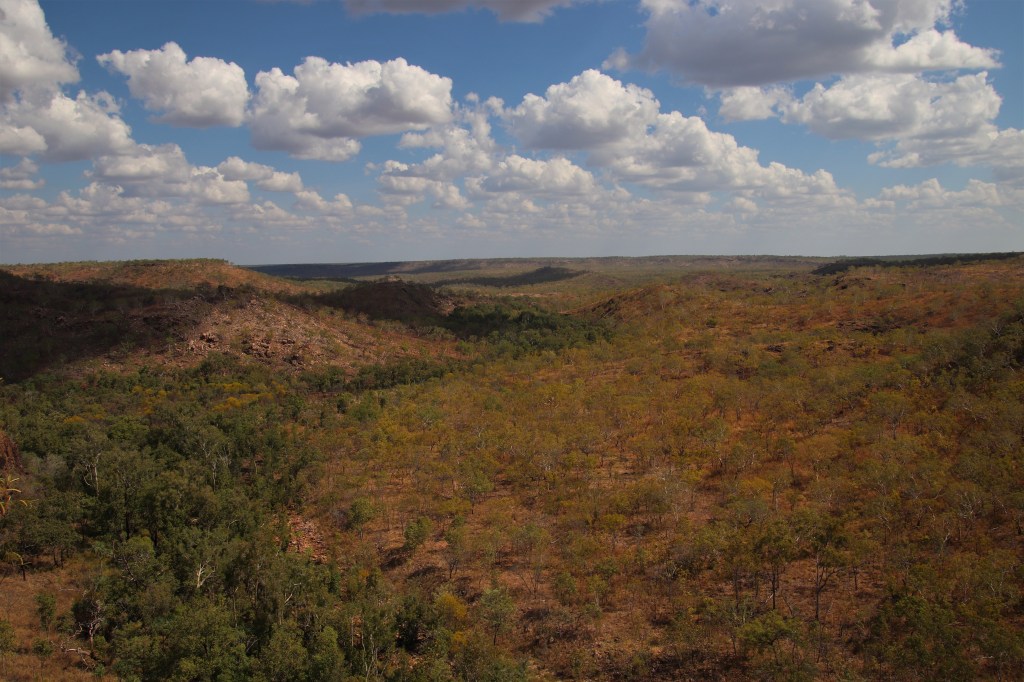
Meanwhile to the right Seventeen Mile Creek tumbled off the escarpment and crashed onto the rocks far below.
Dramatic Seventeen Mile Falls.

It was at this site that the interaction with the previous walkers on the Gecko Transfer Bus payed dividends. At every site there are two campgrounds. One for independant trekkers and a second for tour groups. Since there was no tour groups walking at the time, it meant that an entire campground always laid empty nearby. Often it seemed the independant walkers campground was in the better location, but here at Seventeen Mile Creek I had been advised the independant walker campground, although close to the track provided no shade.
The tour group campground was additional 500m from the track but the diversion was more than worth it, situated on the banks of Seventeen Mile Creek in plentiful shade. The creek was slow moving and lined with bright green pandanus and ablaze with orange flowers of Fern-leaved Grevillea. I ditched my pack and sat in the cool waters of the creek to a cacophany of screeching corellas. White puffy cumulus clouds dotted the deep blue sky, while a flock of around thirty cockatoos meandered up the creek seemingly undecided about a final destination.
Screw Palm (Pandanus spiralis.)
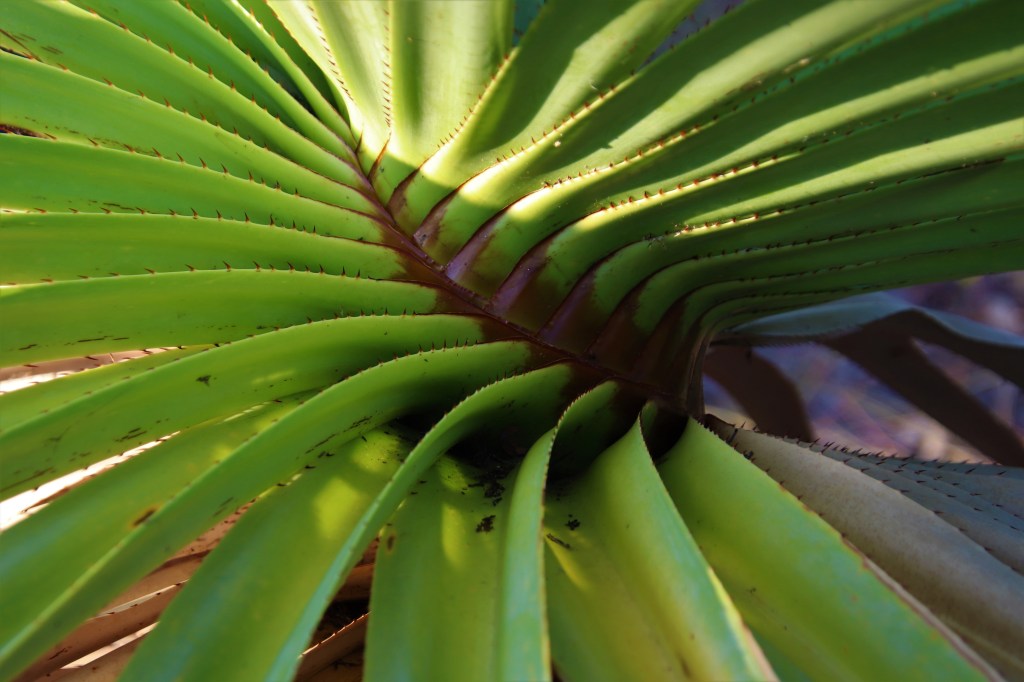
I explored up the creek ever hopeful of an encounter with a Mertens Water Monitor. Sadly, cane toads have decimated the populations of this species in Northern Australia. Returning to camp I did find a Gilberts Water Dragon darting across the rocks. Three other walkers Laura, Jasmine and Chloe joined me at the group campground and I was glad for the conversation. We spent the afternoon slouched lazily wherever there was shade, grateful for what little breeze there was in the stifling heat.
Later that afternoon as the shadows grew long, we decided to visit our fellow walkers camped further downstream near the falls. Clambering first through dense vegetation and then tracing the rocky terrain adjacent to the creek, Laura’s sharp eyes picked out a bird of prey standing in the shallows drinking.
It must have been parched because it tolerated my cautious approach to within thirty metres, when I dared get no closer. Bird identification is not a strong point of mine, and my raptor identification is horrible, and so the identity of the bird remained a mystery.
After returning to Perth I sent the photo to some birder mates, who confirmed a Red Goshawk, the rarest bird of prey on the Australian Continent, and a much sought after bird! What a find, and many thanks Laura.
Red Goshawk drinking from Seventeen Mile Creek.

We spent the late afternoon chatting with the remainder of the group and swimming in the rocky pools above the main falls, returning upriver before dark for an early night under a bright waning moon.
Day 4 – Seventeen Mile Falls to Sandy Camp Pool – 17.6kms.
Today was by far the longest walking day, not especially far in long distance hiking terms, but considering the day was predicted to reach 37C it was sensible to be out of the scorching sun as soon as possible. There had been a sort of collective group anxiety building about today and everyone had planned for an early start.
At 4.30am the phone alarm wrenched me from sweet sleep. Breakfast at this early hour was not a consideration. I woke the girls and set off down the creek. The walkers at the other campsite were rousing as I passed through. The track is initially rocky and steep but soon levels out for the remainder of the day.
The night was pitch black but the reflective markers on the trail were easy to view. The moon had slipped from the sky hours earlier, leaving the only light in the heavens coming from the untold number of stars. It was incredibly peaceful, the still of the night broken only by a pair of distant Boobook Owls calling across the woodland. Five kilometres in I took a break at a pandanus-lined creek watched by an enormous Cane Toad.
Slowly but surely daylight crept over the horizon and the day gained her colours. The early morning light revealed huge numbers of termite mounds dotted across the landscape, they reminded me of the headstones of a graveyard.
Termite Mounds.
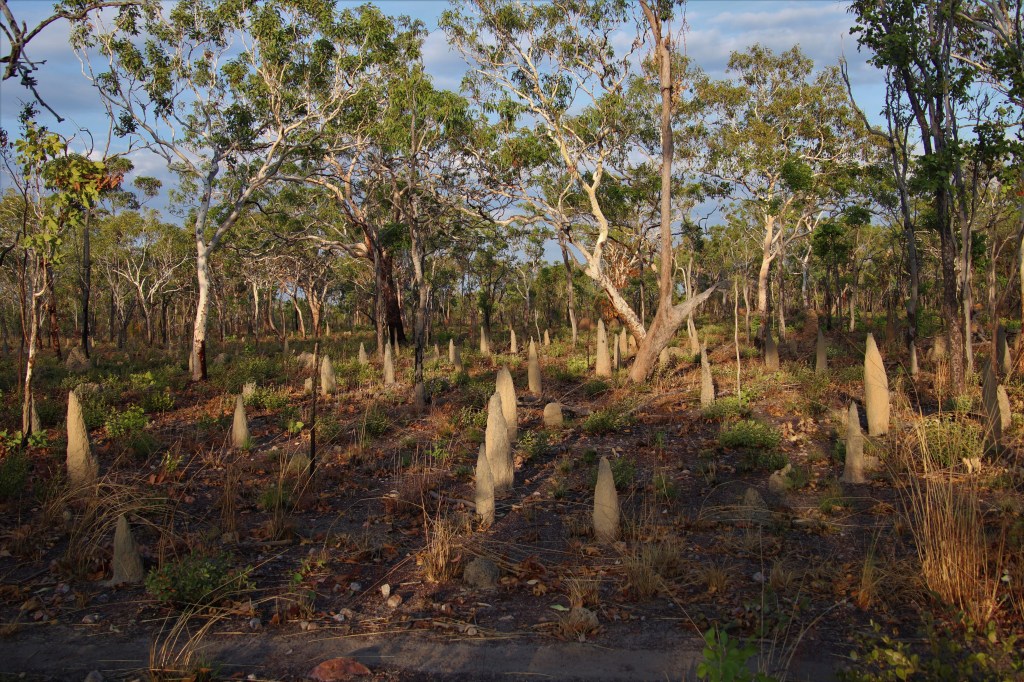
Twelve kilometres from Seventeen Mile Falls I had been on the trail for three hours, happy with the distance covered, I set up on a rock slab surrounded by the scandalous yellow of a forest of flowering Acacia and finally ate breakfast. A family of Great Bowerbirds foraged through the canopy above.
Shortly afterwards I reached a water-hole smothered with Water Lilies. The pink and yellow flowers fluttering over giant green pads. This was the Edith River and the Jatbula Trail would follow this riverine corridor as it rambled across the floodplain towards Leilyn (Edith Falls,) two days hence.
Water Lily, Edith River.

The trail became rocky after this pool on the approach to Channel Waterhole, where I stopped for a further break. I searched for Mertens Water Monitors but once again to no avail. While I searched I was joined by Adam and Renee and so I had company as I walked the final hour into Sandy Pool Camp. The verdant vegetation consisted of paperbarks and pandanus ensuring this part of the walk was well-shaded. Just as well, the temperature was now in the mid-30’s.
Suddenly the vista opened up to the broad expanse of Sandy Camp Pool. The campsite itself was one of the best on the trail, well-spaced, shady and sandy underfoot, but best of all adjacent to a giant swimming hole filled with deliciously cool water. Previous walkers had removed stones from a nearby rocky ridge to make an assortment of tables and chairs and in the process made the campsite feel rather homely.
The still waters of Sandy Camp Pool.

It was 11.30am and after choosing a tent site I slid down the steep bank and was enveloped by the crisp, cool waters. I lay on my back and watched the white woolly clouds resulting from the intense heat as they hung suspended in the sun-baked sky, while the most gentle of breezes rustled the pendant leaves of the pandanus around the pool.
Within an hour all of the group had arrived, and it was decided that if a group photo was to be taken then it would have to be on this day, as four of the group would be pushing on through Sweetwater Pool Campsite to finish the trail on the following day. Laura decided on a water backdrop for the photo and so I duly set up the tripod and the group assembled.
The only problem was the timer on the camera was only ten seconds and in that time I would need to activate the camera, jump into the water and swim through a mat of weeds for 30 metres to join the group. This doesn’t sound easy and it wasn’t, but it provided everyone with much needed laugh after what had been a tough day. I look now at the photo and I couldn’t have asked for a nicer bunch of people with which to have walked the trail.
Group Photo at Sandy Camp Pool.

The remainder of the afternoon was spent playing cards, crosswords and chatting. I had a brief walk downriver to check out the country for the following morning and disturbed a snake that I though might have been a whip snake off the trail.
A number of the group joined together for a spotlight after dark. The first discovery was a pair of red reptilian eyes at the far side of the pool. The owner was a Freshwater Crocodile, harmless to man if left alone. Fruit Bats were also common feeding in the canopy, especially where there was fern-leaved grevillea.
Little Red Flying Fox feeding in Fern-leaved Grevillia.

Day 5 – Sandy Camp Pool – Sweetwater Pool – 11.3kms.
The following morning after a deep sleep, I was woken just on daybreak by a colony of noisy Flying Foxes flying upriver like a group of late-night revellers returning from a party. I propped against a tree and enjoyed the stunning colours of the dawn sky silhouetting the paperbarks around the pool.
Daybreak at Sandy Camp Pool.
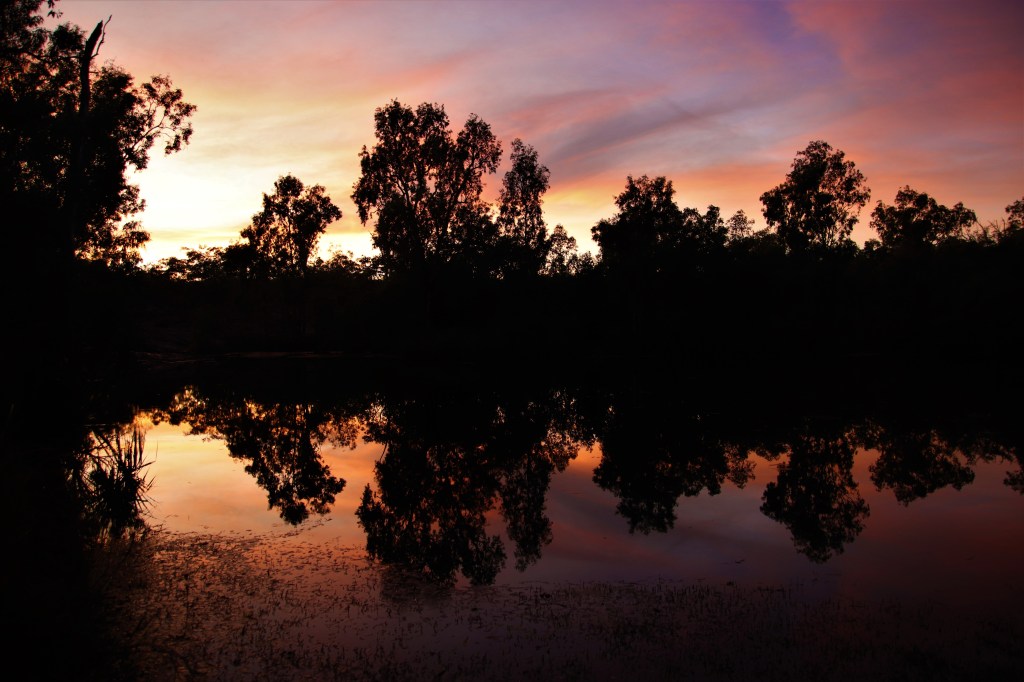
The group of sixteen was reduced to twelve when after a series of sad goodbyes Matt, Elizabeth and the two Britts walked out for Leilyn (Edith Falls.) to finish the trail.
There was a more relaxed feel amongst the remaining walkers that morning, knowing the distance was much shorter than that of the previous day. Striking camp, a shriek from Renee revealed an enormous huntsman spider on her tent. This was a truly epic arachnid and I’m sure if I had seen it before Renee my screams would have been considerably louder!
The first few kilometres out of Sandy Camp Pool remained sandy underfoot and hard going, although the track quickly firmed up thereafter. I was in the zone when I disturbed a basking snake which shot off into the undergrowth, but with enough time to identify the species as the same seen the previous afternoon. I made good ground over the course of the early morning stopping only to watch a pair of lorikeets check out a nesting hollow in a large Bloodwood.
On the approach to Sweetwater Pool the track, as a series of boardwalks, passed over a marshy area of Banksia dentata before traversing an area of rocky ledges on the final approach into Sweetwater Campsite. As I staked out my site amongst the trees of the campsite a Sulphur-crested Cockatoo was enjoying a mid-morning sugar hit from the Fern-leaved Grevillea overhead. It was 10.30 am and I had been walking for 3 hours.
Sulphur-crested Cockatoo.
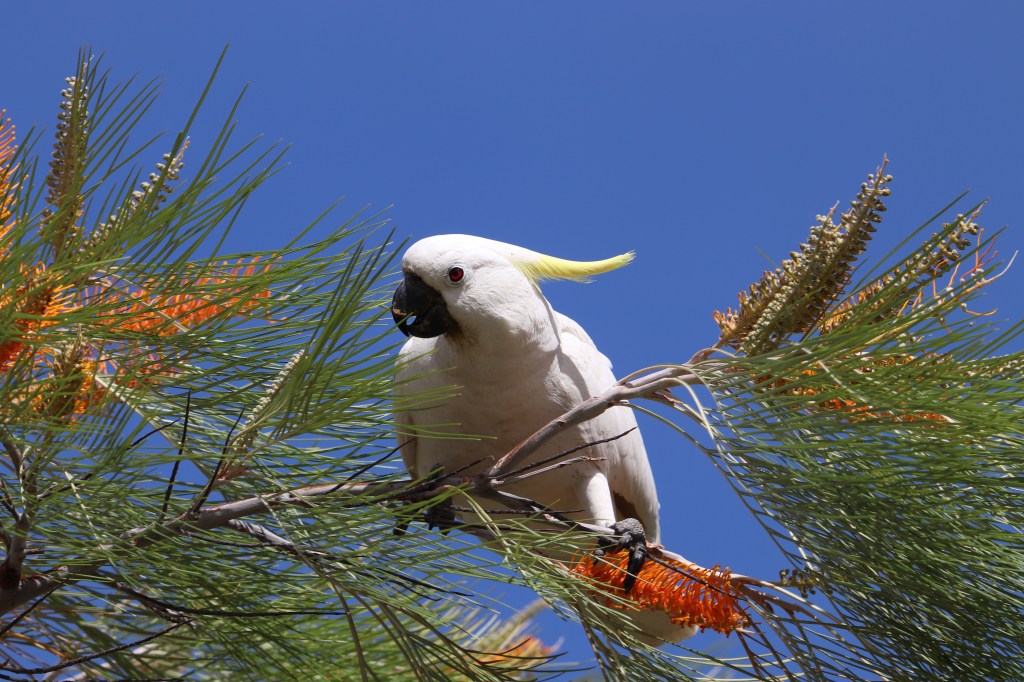
Once the entirety of the now smaller group had arrived we retired to the meagre shade provided by the rock ledges surrounding the periphery of Sweetwater Pool. The pool itself was large, and in places deep and so a lazy afternoon was spent alternating between cooling dips and crosswords. The latter had become a regular and much-enjoyed group activity during the heat of the day.
Small cascades empty into Sweetwater Pool.

Eagle-eyed Laura once again came up trumps and discovered a small Mertens Water Monitor splayed on the sunbaked rock ledge to warm after a hunting expedition in the cool waters.
Mertens Water Monitor.

Within our group of independent walkers were a loosely associated group of nurses, midwives and friends. These girls were a hoot, and you could hear them on the trail long before you saw them. On this last night they cooked a delicious dessert for everyone. I had been eating my ususal fare of muesli, tuna and noodles, so this was a welcome treat, and a lovely gesture. Sometimes it’s the small things remembered on a long distance walk.
Later after dinner Adam discovered a Pygmy Mulga Snake on a trail near the campsite. Inspired by the find Laura, Adam and myself set out for a spotlight upstream. There was a small Freshwater Crocodile on rocks at the side of one pool, at least three species of frog including the ubiquitous Rocket Frog, Flying Foxes in the Fern-leaved Grevillea but undoubtedly the find of the night was tiny Northern Shovelnose Snake. Adam is something of a mad herper and noticed that the posterior end of the tiny serpent was swollen, which is indicative of a recent yolk sac attachment. He thought this snake hatched within the previous 12 hours!
Northern Shovelnose Snake.

Day 6 – Sweetwater Pool to Leilyn Falls – 4.4kms.
We enjoyed another lesiurely start to a day because there was now only 4.4kms to finish the Jatbula Trail. Additionally the Gecko Tours transfer back to Katherine Vistor Centre was not until 1.30pm.
The trail continued to follow the course of the Edith River with occasional glimpses. The topography switched between savannah woodland and rocky outcrops. What did differ on this day was an abundance of new faces as day walkers made the short hike from Edith Falls Carpark to Sweetwater Pool.
After 3.5kms there is a side track and steep descent to the upper pool of Edith Falls. The pool was deep and excellent for swimming. In addition there were a series of rock ledges to jump off and the inner child in me couldn’t resist. It was a great place to while away time until it was time to knock-off the last kilometre.
Upper Pool – Edith Falls.

My expectations were low as I approached the kiosk at Edith Falls Carpark, previous walkers had advised that due to covid-induced staff shortages the kitchen was closed and the venue was serving a reduced menu, so no burgers.
I made the best of the situation and quickly polished of some uninspiring chicken/salad sandwiches, a delicious white choc macadamia cookie and a chocolate bar, all washed down with a caramel milkshake. I could almost feel my waistline expanding.
The original plan had been to spend a night in Katherine and catch the pre-dawn greyhound bus back to Darwin the following morning, but I was delighted to find a space going begging in Laura’s car that afternoon. What followed was a delightful car journey with Laura, Izzy, Jaz and Chloe debriefing the amazing time we had spent walking.
To summarise the Jatbula Trail. It was certainly a much easier walk than the Larapinta with it’s gigantic climbs and descents, but on the other hand the heat of the Jatbula was like nothing I have ever experienced on a long distance walk. The daytime highs were 35C to 37C every day, tough conditions indeed.
I suspect booking may be easier in the shoulder season than in peak season when I walked, but the flip side of this of course are the conditions on the trail. If we were getting 35C in early August I dread to think how the heat and humidity would be in late September.
I had a couple of nights R’n’R in Darwin where I once again searched unsucessfully for owls at the Botanical Gardens. Then it was goodbye to the NT for now, and time to head across to Queensland…..
Continued in Northern Australia Part 3 – Wildlife of Outback Queensland
#QuollingAround
Almost felt I was part of the group and on the trail with you all from your description.
I enjoyed the record of your experiences and the wildlife encountered on your journey. The Scenery and photographs were first class.
LikeLike
Thanks Dad. It would have been great to have had you on the walk!
LikeLike
Looked like more sheilas than blokes in your “group”. Would that be right?
Water pools and waterfalls were the always the highlight of the trail, much like how the Aboriginal people would have used and enjoyed the journey.
Your photo of the Red Goshawk was a winner for me.
LikeLike
Hey G the boys were definitely outnumbered by the girls 13 to 3. The Red Goshawk was also a highlight of mine even before I knew what I was looking at 👀
LikeLike
What an amazing adventure, your descriptions, photos and impressions are so vivid we also felt we were experiencing your discoveries and the excitement of stumbling across some rare sights like the Red Goshawk and the remote Indigenous Rock Art site. I could almost feel the heat building during the day and the soothing coolness of the water in the rock pools and falls. You have captured the magic of the Australian bush and made it accessible to your readers. Biddlecombe Falls and the red sunsets are an artists stroke.
LikeLike
Hey Cheryl I’m glad you enjoyed the read. I carried the camera tripod for the 62km but it certainly paid off at Biddlecombe Falls!!!
LikeLike